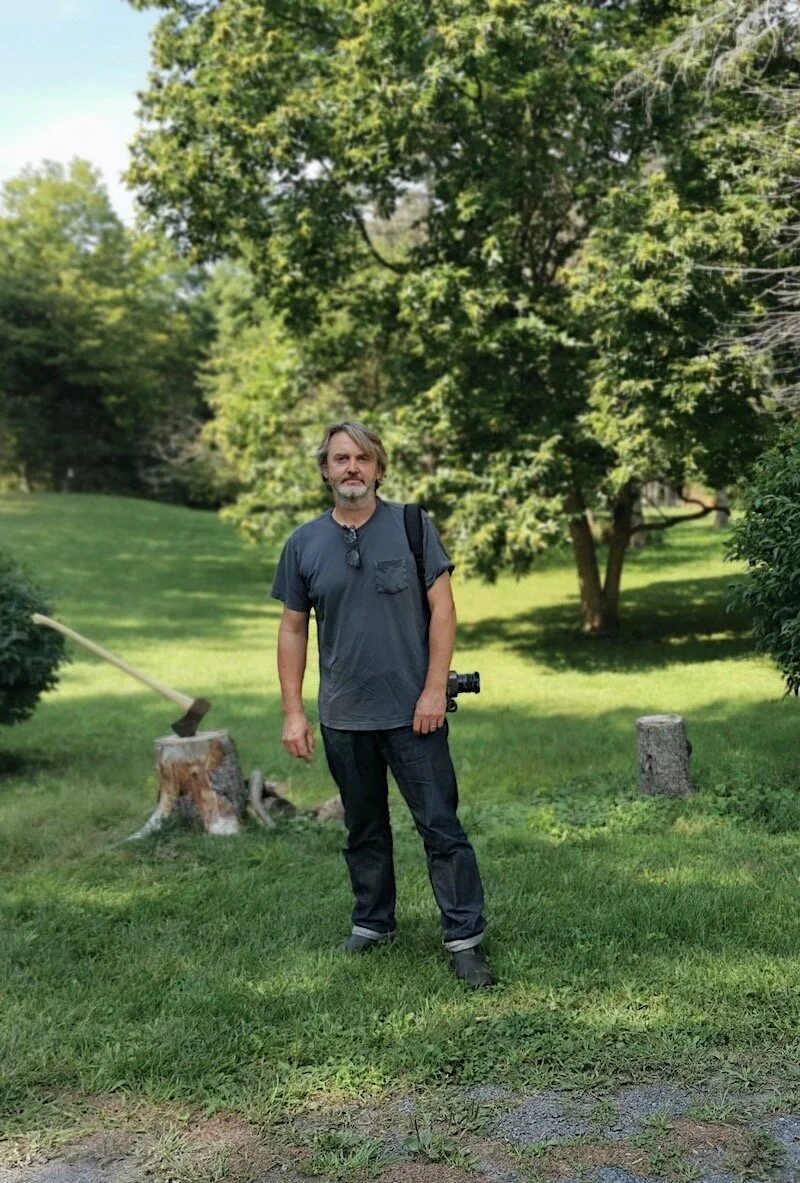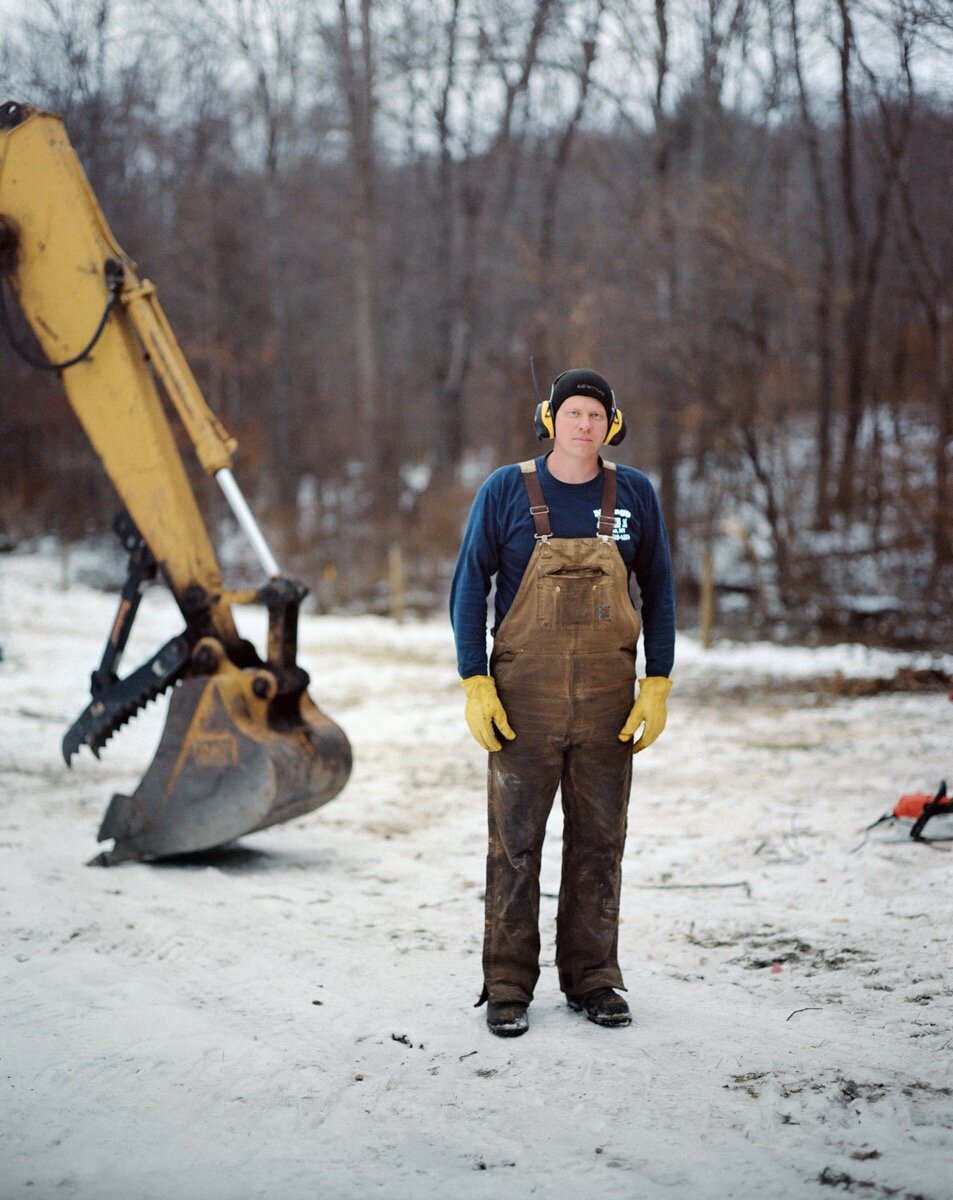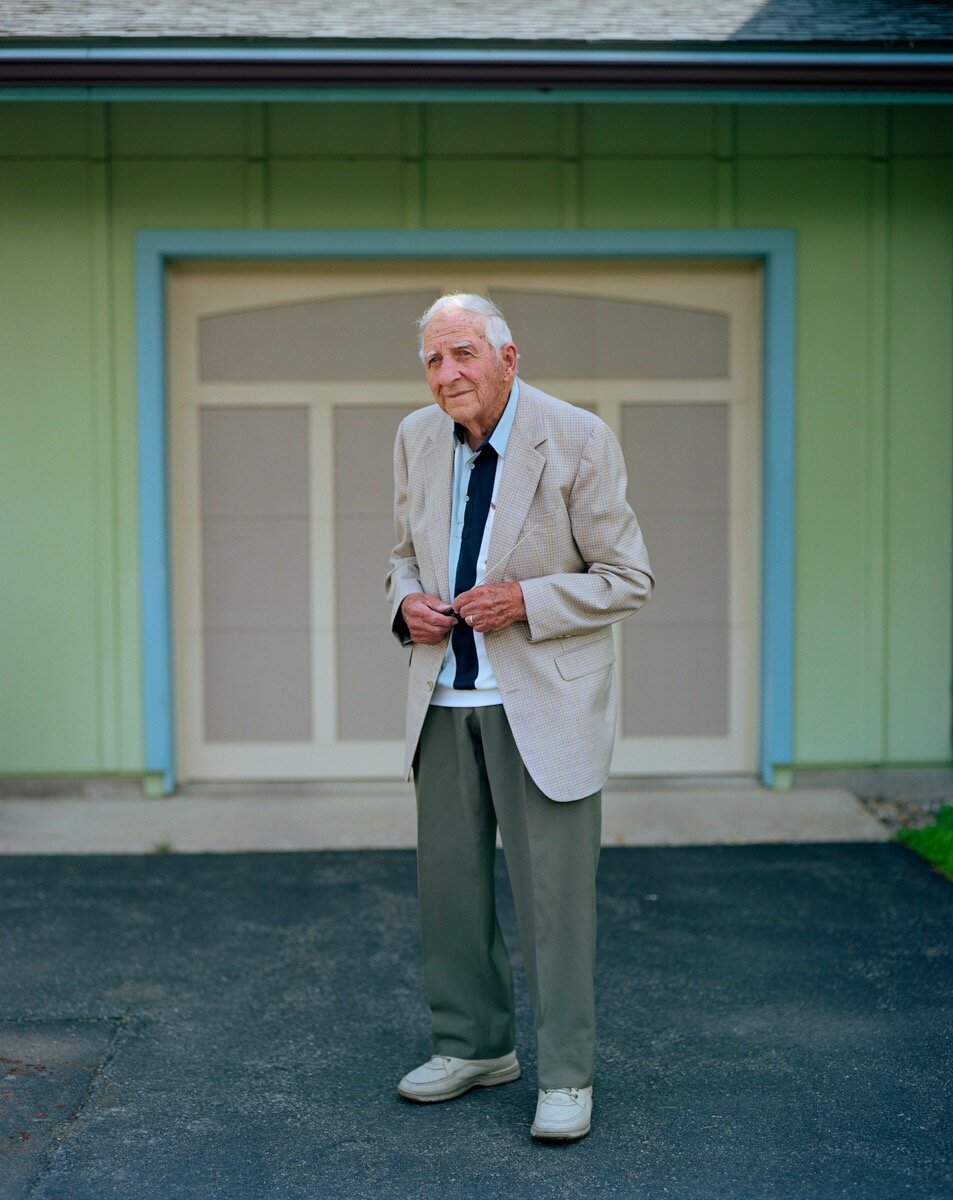We first met Richard and his family several years ago, when they had just moved full-time to the town of Ghent, New York. The Beaven family have since stewarded several projects, including their much-loved family-run farm, Made in Ghent, and Richard, an ex advertising executive with a nearly life-long affinity to photography, has spent much of the past years traveling up and down the Hudson Valley, documenting rural American life. Richard’s work is raw, bringing the authenticity and character of his subjects to the foreground. Over the span of a year, from late 2017 to late 2018, Richard began shooting a collection of 276 portraits of Ghent’s residents, taken to document and memorialize the town’s 200th year. The photos are immersive, drawing you in to an unfiltered snapshot of a small town and the people who define it.
Richard Beaven, hard at work.
Photo by Melanie Wesslock
After submitting a print of each photograph to the town and a subsequent gallery exhibition, Richard decided to bring this powerful collection to a wider audience. In October of this year, Richard released his book, All of us: Portrait of an American Bicentennial. Upon viewing the collection all at once, featuring its forward by Kira Pollack and an essay by professor Tom Lewis, one feels that Ghent’s story, its landscape, and its people, are complex, relevant, and beautiful. Here, Richard shares with us his process, and some lasting reflections on the life-changing experience of documenting the town he and his family call home.
Has the All of Us project changed your perception and experience of life in Ghent? Especially in contrast to how you may have felt as a newcomer to the town.
It’s been a while since I was a newcomer. Rather than having changed my perception of the town I think it has reinforced my sense of Ghent (and many towns across the country and world like it) being a great place to be. Like any town, differences and challenges exist but the underlying sense of community quickly rises to the surface when needed. We are lucky to live in Ghent and what I describe here is what first brought us, and has since connected us, to the area.
Did your subjects get to choose the environment you shot in? Or did you choose it for them?
I like the idea of meandering. When I arrive at a location I start seeing any challenges and opportunities including where to photograph. Sometimes people have specific thoughts about where they want to be photographed. Normally I try their idea and then, usually, meander eventually to where I believe a picture will work best, where the elements come together to make a powerful portrait. Using a film camera arguably creates a more paced, considered and deliberate approach which I use to my advantage. But that’s just my choice.
All of Us at its core started largely as a way to create a visual snapshot of the town of Ghent and its residents on its bicentennial, and you provided the town original prints of all 276 portraits. When, and why did you make the decision to transform the project into book form?
The motivation for the project was to create some sort of archive for future generations of Ghentites. Mainly due to smartphone technology, collectively, we have never taken so many photographs yet so, so few are ever printed out and stored. They lie in waste, in old phones in basements. With individual prints delivered to each person involved, a full set given to the town historian for the archive, and an exhibition of all the portraits, it all could have ended there. In 2019 I was introduced to Daylight Books, a not-for-profit organisation dedicated to discovering and sharing photography, by a mutual friend. We agreed to publish the work as a book on a co-funded basis.
In that vein - your project is about to have an expanded audience due to the imminent launch of the All of Us book. What do you hope audiences from completely different contexts will experience when viewing all of your portraits?
A sense of place. An insight that a town is defined by its people. A feeling of hope and unity perhaps. These are challenging and divisive times during which we are being forcefully reminded of the power of communities; big or small, new or old, physical or virtual, we need them more than ever. I would like to think that people spend time with the book, read the wonderful texts and see that I have endeavored to treat every person involved with respect and dignity.
Who was your first subject for the project? Could you tell us a little bit about the story of how you ended up with that first portrait?
I first photographed Gary, who processes deer for local hunters. I rolled up his driveway one day and introduced myself. A few days later we made a portrait and made a date for me to return as at that time, deer season had only just started and things were quiet. When I reviewed my film I didn’t like anything about the portraits. Nothing. Over the period of two weeks, before I returned, I figured out why. Simply that the portrait provided way too much information, it was a factual report of the scene and viewers of the photograph would be left with no questions to ask or need to use their imagination.
When I returned I simplified the whole scene, I removed certain elements and it made what I consider to be one of the most successful portraits in the series. There was only one other occasion when I photographed someone twice. This need to give the viewer a role is why the portrait captions are at the back of the book not with each photograph. I would like viewers to just see and relate to the person in the photograph.
You say that All of Us is meant to reflect the diversity and nuances of the entire Ghent population. In fact, you were able to photograph an unprecedented amount of the town’s population. How did you go about choosing these subjects?
This was not a census of any sort. There was no checklist. In some cases I had an idea of people to photograph. Sometimes I would simply see a great background, meet someone in the street, stop at their houses and knock on the door. There was a lot of emailing, calling and writing. One of the most effective means of finding new people was word of mouth and recommendation of course. I was helped along by many people around the town. In the end only four or five people declined to be photographed.
Kate Lippert, 7 years.
Many would argue that the obvious choice when documenting a town would be to capture both landscapes/buildings as well as portraits of residents. Yet, after viewing photographs from All of Us, which are exclusively portraits, we are immersed in the atmosphere of the town and have such a clear feeling of its soul. What made you choose portraiture as the method for this project?
I was very gratified to receive feedback from a number of people about this. Joe Mandese writing in Mediapost magazine commented: "I still hope to visit Ghent someday, but in many ways, I feel I already have”. For me that sums it up. I am drawn to people, to photographing them, it’s a collaboration and I do it the most thoughtful way I can. A town is not defined by its perimeter or its buildings, it is defined by its people.
I would like to think that after viewing the portraits that the people and environments around them work together to build this sense of the place. One plus one equals three. Magic.
Ghent is located in a part of New York State that we would colloquially call a ‘Red’ region. Do you feel that All of Us is not just a memorialization of a small town’s Bicentennial, but also of a time in American politics where the influence of rural America and its residents has been significantly prevalent?
Firstly there is nothing (actual or intended) political about this work. Being as objective as possible during these projects I don’t care that the region is red or blue or any other colour. I want to meet, better understand and photograph my neighbours. Have we forgotten how to talk to or trust people with different views than ourselves? The Ghent work does describe and archive the town’s bicentennial through the people that were here in 2018. Yes, rural areas have come into focus in recent years and what ‘small town America’ is anymore has been much discussed.
Over the longer term I have chosen to create separate but related self-initiated series of environmental portraits, in the Hudson Valley area and hope to create a wide-ranging survey of our time examining cultural, and socio-political themes with a goal to contribute meaningfully to the broader archive during this transformative time in American history.
Has this project made you feel a greater kinship and sense of belonging in this town?
Inevitably, yes. More than eighty percent of the people I photographed were strangers beforehand. I’ve travelled pretty much every mile of the roads around Ghent. We had a reception for the opening of a show at Art Omi (a Sculpture park and gallery here in Ghent) and more than 300 people showed up, people from all backgrounds and walks of life. It was a wonderful, memorable experience to see the town coming together like that. I was blown away.
Daryl Lee, 9 years.
When did you know the project was complete and a sufficient amount of portraits had been taken? And looking at the breadth of portraits captured for All of Us, do you feel you have been successful in capturing the essence of Ghent at this period in time?
There was no target in terms of the number of portraits. At the beginning I thought perhaps I would get to fifty. 276 portraits later it was time to conclude. It’s not a science. I simply had a sense of completion, that I had created as good a representation of the town as I could. Also there came a point where I had to switch from photographing to producing prints for the exhibition. Logistics and resource availability limit us eventually.
And lastly, if you could say a few words to the many people who agreed to be photographed for All of Us, what would you say?
I am deeply indebted to the people of Ghent, not only for their time and great support but, for showing me that we have more in common than that which separates us. What a gift - thank you.
All portraits in this article, with the exception of the first image, are featured in All of Us: Portraits of an American Bicentennial, and have been kindly provided by Richard Beaven.










